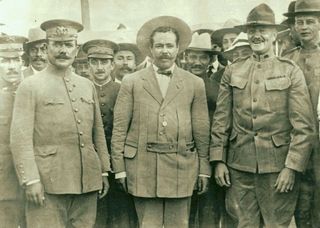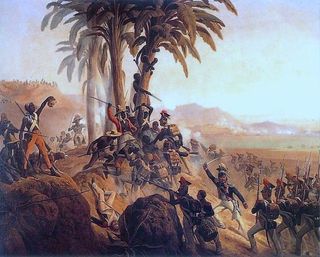The Top 7 Wars that would make awesome games
If games ever get tired of recycling the same historical settings, here are a few places we'd like to see them go
2. The Mexican Revolution
What it was: It’s no secret that Mexico has had a long and tumultuous history, but some of the most notable tumult came at the dawn of the 20th century. Centering around the struggle between Mexico’s downtrodden peasants and its wealthy, land-owning elite, the Mexican Revolution was actually a series of conflicts that began in 1910, when Mexico’s dictatorial president, Porfirio Diaz, realized he stood a chance of losing the election and had his opponent, Francisco Madero, jailed. This is, of course, never a good idea if you’re trying not to look like a dictator, and a popular revolt by Madero’s supporters quickly followed, ousting Diaz and installing Madero as president the following year.
After a couple of years, Madero proved to be a less-than-satisfactory president, prompting revolutionary Emiliano Zapata to gather an army and attempt to overthrow him. Mexico’s own military managed to beat him to it, however, overthrowing Madero in a U.S.-backed military coup and installing a new dictator. This brought together four revolutionary factions led by Zapata, Pancho Villa, Alvaro Obregon and Venustiano Carranza, who deposed Huerta within a year and immediately began fighting amongst themselves.
For the next six years, the four factions allied in different formations against each other, with one taking over the government and the others trying to topple him. Meanwhile, the US was worried about its interests and sent an expeditionary force (led by Gen. John J. Pershing) south of the border, and the Germans sent guns and money, eager to open yet another front for WWI. Obregon and Carranza both became president, while Zapata and Villa both became dead (but more famous). And while a series of assassinations and failed rebellions lit up the ensuing years, things became more or less stable from that point on.

Above: Obregon, Villa and Pershing in a rare moment of not trying to kill each other
Why it’d make an awesome game: Technically, it already has made an awesome game, if you count the heavily fictionalized version of it found in Red Dead Redemption. Just the same, we’d like to see the real thing, especially considering that RDR’s take represented just a sliver of what really happened.

Above: This was good for a start, though
The 20-year period of south-of-the-border chaos and violence (which at one point reportedly included American soldiers tying the bodies of dead rebels to their cars like trophies) has been the setting for a number of fantastically over-the-top spaghetti westerns, so there’s no reason games couldn’t horn in on that action, especially if it means seeing the war from the perspective of the Zapatistas or Pancho Villa’s army (which included a number of American expats out to strike a blow against tyranny, if you really need an English-speaking protagonist to connect with). And also if it means shooting Gatling guns at mechanized government infantry while on horseback.
Sign up to the 12DOVE Newsletter
Weekly digests, tales from the communities you love, and more
1. The French Revolution
What it was: In the minds of many, the French Revolution wasn’t really a “war” so much as it was a popular uprising. Poverty-stricken revolutionaries stormed the Bastille; the military was either overwhelmed or refused to fight; the powdered, out-of-touch aristocracy was marched straight to the guillotine; and everyone ate cake. And that’s what we all learned from A Tale of Two Cities, right?

Above: And then the Reign of Terror happened, and, uh, Napoleon, I guess?
What makes the French Revolution interesting isn’t just all the beheadings, or the Reign of Terror, or the idea of France adopting a secular, democratic government for the first time. It’s how insane things got after that. See, the rest of Europe at the time was still ruled by monarchies, most of which had some relation to France’s Louis XVI, and they weren’t about to let him go down without a fight. They also sure as hell weren’t going to let this “republic” bullshit find a foothold on their doorsteps, and so Spain, Britain, Turkey, Russia and the Holy Roman Empire – which included Germany and Austria, and was run by Marie Antoinette’s brother – all took turns trying to smack the new French Republic down.
Contrary to what watching The Simpsons taught us, France began kicking ass. Horrible, horrible amounts of ass. The so-called Revolutionary Wars that came in the wake of the Revolution saw France take over most of its neighbors, including Italy, where the French Republic went so far as to depose the Pope. The only real defeat France saw during this period was in Haiti, where the slave population had decided to follow France’s revolutionary example.

Above: These guys did pretty well against the French Republic. The Pope and most of Europe? Not so much
Interestingly, if it hadn’t been for the string of amazing victories by France’s new republican overlords, a lieutenant by the name of Napoleon Bonaparte would probably not have risen so rapidly through the ranks of the French military – and would never have effectively ended the Republic by declaring himself Emperor.

Above: Whoops
Why it’d make an awesome game: Good lord, why wouldn’t it? The French Revolution is a blast of national-scale chaos and horror followed by one of the most rapid conquests and military expansions Europe had seen in ages. If that’s not an ideal backdrop to explore through a historical re-creation, then what is?
Actually, it probably will be the backdrop of a game pretty soon, if Assassin’s Creed III follows the pattern of the last three games and sends a somewhat aged Connor to France in next year’s sequel. But why let Assassin’s Creed have a monopoly on cool historical fiction, especially when there’s so much ground to cover?
Most Popular


